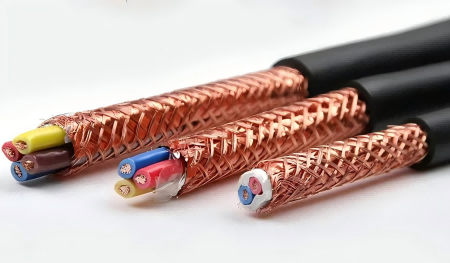We know that different cables have different performances and therefore different structures. Generally, a cable is composed of conductor, shielding layer, insulation layer, sheath layer, and armor layer. Depending on the characteristics, the structure varies. However, many people are not clear about the differences between insulation, shielding, and sheath layers in cables. Let’s break them down for better understanding.
(1) Insulation Layer
The insulation layer in a cable primarily provides insulation between the conductor and the surrounding environment or adjacent conductors. It ensures that the electric current, electromagnetic waves, or optical signals carried by the conductor are transmitted only along the conductor without leaking externally, while also safeguarding external objects and personnel. The performance of the insulation directly determines the rated voltage a cable can withstand and its service life, making it one of the core components of the cable.
Cable insulation materials can generally be divided into plastic insulation materials and rubber insulation materials. Plastic-insulated power cables, as the name suggests, have insulation layers made of extruded plastics. Common plastics include Polyvinyl Chloride (PVC), Polyethylene (PE), Cross-Linked Polyethylene (XLPE), and Low Smoke Zero Halogen (LSZH). Among them, XLPE is widely used in medium- and high-voltage cables due to its excellent electrical and mechanical properties, as well as superior thermal aging resistance and dielectric performance.
Rubber-insulated power cables, on the other hand, are made from rubber mixed with various additives and processed into insulation. Common rubber insulation materials include natural rubber-styrene mixtures, EPDM (Ethylene Propylene Diene Monomer rubber), and butyl rubber. These materials are flexible and elastic, suitable for frequent movement and small bending radius. In applications such as mining, ships, and ports, where abrasion resistance, oil resistance, and flexibility are critical, rubber-insulated cables play an irreplaceable role.
(2) Sheath Layer
The sheath layer enables cables to adapt to various usage environments. Applied over the insulation layer, its main role is to protect the inner layers of the cable from mechanical damage and chemical corrosion, while also enhancing the mechanical strength of the cable, providing tensile and compressive resistance. The sheath ensures the cable is protected from mechanical stress and environmental factors such as water, sunlight, biological corrosion, and fire, thereby maintaining long-term stable electrical performance. The quality of the sheath directly affects the service life of the cable.
The sheath layer also provides fire resistance, flame retardancy, oil resistance, acid and alkali resistance, and UV resistance. Depending on the application, sheath layers can be divided into three main types: metallic sheaths (including outer sheath), rubber/plastic sheaths, and composite sheaths. Rubber/plastic and composite sheaths not only prevent mechanical damage but also offer waterproofing, flame retardancy, fire resistance, and corrosion resistance. In harsh environments such as high humidity, underground tunnels, and chemical plants, the performance of the sheath layer is particularly crucial. High-quality sheath materials not only extend cable service life but also significantly enhance safety and reliability during operation.
(3) Shielding Layer
The shielding layer in a cable is divided into inner shielding and outer shielding. These layers ensure good contact between the conductor and insulation, as well as between the insulation and inner sheath, eliminating increased surface electric field intensity caused by rough surfaces of conductors or inner layers. Medium- and high-voltage power cables generally have conductor shielding and insulation shielding, while some low-voltage cables may not be equipped with shielding layers.
Shielding can be either semi-conductive shielding or metallic shielding. Common metallic shielding forms include copper tape wrapping, copper wire braiding, and aluminum foil-polyester composite tape longitudinal wrapping. Shielded cables often use structures such as twisted pair shielding, group shielding, or overall shielding. Such designs provide low dielectric loss, strong transmission capability, and excellent anti-interference performance, enabling reliable transmission of weak analog signals and resistance to strong electromagnetic interference in industrial environments. They are widely used in power generation, metallurgy, petroleum, chemical industries, rail transit, and automated production control systems.
As for shielding materials, inner shielding often uses metallized paper or semi-conductive materials, while the outer shielding may consist of copper tape wrapping or copper wire braiding. The braiding materials are usually bare copper or tinned copper, and in some cases silver-plated copper wires for enhanced corrosion resistance and conductivity. A well-designed shielding structure not only improves the electrical performance of cables but also effectively reduces electromagnetic radiation interference to nearby equipment. In today’s highly electrified and information-driven environments, the importance of shielding is increasingly prominent.
In conclusion, these are the differences and functions of cable insulation, shielding, and sheath layers. ONE WORLD reminds everyone that cables are closely related to life and property safety. Substandard cables should never be used; always source from reputable cable manufacturers.
ONE WORLD focuses on supplying raw materials for cables and is committed to providing customers with high-quality solutions. Our products cover various insulation, sheath, and shielding materials, such as XLPE, PVC, LSZH, Aluminum Foil Mylar Tape, Copper Tape, Mica Tape, and more. With stable quality and comprehensive service, we provide solid support for cable manufacturing worldwide.
Post time: Aug-20-2025


